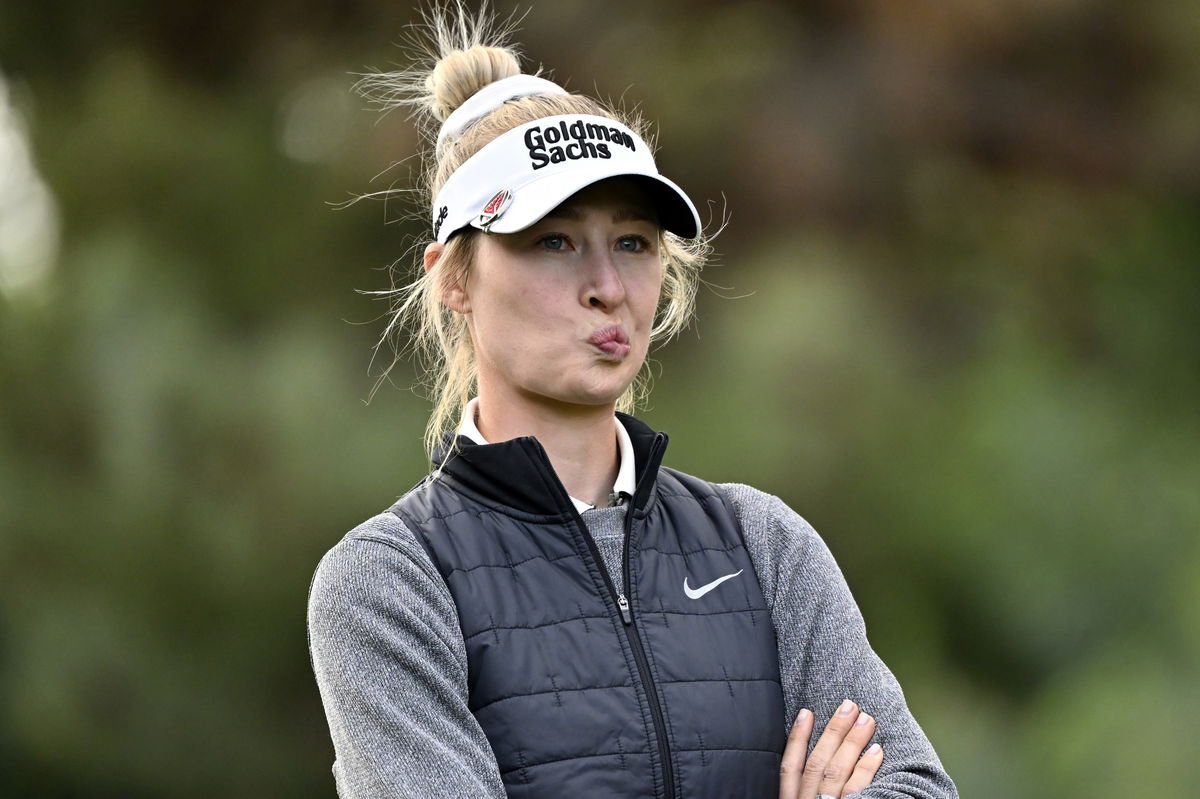
Getty
LAS VEGAS, NEVADA – APRIL 03: Nelly Korda of the United States looks on from the 11th tee during the second round of the T-Mobile Match Play presented by MGM Rewards 2025 at Shadow Creek Golf Course on April 03, 2025 in Las Vegas, Nevada. (Photo by David Becker/Getty Images)

Getty
LAS VEGAS, NEVADA – APRIL 03: Nelly Korda of the United States looks on from the 11th tee during the second round of the T-Mobile Match Play presented by MGM Rewards 2025 at Shadow Creek Golf Course on April 03, 2025 in Las Vegas, Nevada. (Photo by David Becker/Getty Images)
“Golf course design that makes it so tricky,” said Nelly Korda as she didn’t have her best outing at the 2025 KPMG Women’s PGA Championship held at Field Ranch East, finishing tied for 19th after a week of battling tough conditions. When asked about her performance, Korda pointed straight to the course setup as the main reason behind the struggles. “It is a major championship, and it should play hard,” she said. She indeed made some good shots on the field, “but good shots need to also be rewarded,” she added. With winds gusting up to 35 mph and tight pin placements on firm greens, she explained it was nearly impossible for LPGA players to hold their shots. And Korda was not the only one with complaints about the course…
Watch What’s Trending Now!
Charley Hull shared a similar view. She finished tied for 12th overall; her concern was the slow pace of play; for her, the course size was quite big, which led to lags in rounds.“It’s quite a big field, isn’t it?….the golf courses are hard, so it’s a hard one, really.” In other words, she’s saying it’s not just the players, it’s the brutal setup that’s slowing everyone down. And even Stacy Lewis supported Hull’s point of view with similar concerns. However, not everyone saw it the same way.
Contrary to Charley Hull‘s take, on the other side of the leaderboard and the debate, Auston Kim, who finished tied for 2nd, saw things differently. For her, the course wasn’t unfair; it just played to certain strengths. “I think it really depends on your game, what your strengths are, what your abilities are,” said Kim on the Fried Egg Golf Podcast. She pointed out that she hits the ball farther than most and can generate more spin, which helps her control shots better and stop the ball on the greens, even in windy conditions. “Compared to other players on like I hit it farther and I generate more spin.” In her case, the same setup that challenged others actually gave her an edge.
ADVERTISEMENT
“So a lot of things about this course that made it difficult for the rest of the field were a bit more advantageous for my game,” she said. Kim wasn’t just managing the conditions; she was thriving in them. Her ability to carry the ball longer and control spin gave her just the edge she needed, especially when others were grinding just to make par.
View this post on Instagram
She found that the course demanded a type of discipline and decision-making that played to her strengths. “A course that’s long, in the wind… requires a lot more discipline, requires good decision making in terms of selecting targets,” she said. For Kim, the firm conditions and windy layout, which were a trouble for Korda, were opportunities for Kim to lean into her game plan and execute with confidence. And moreover, Kim enjoys tough courses.
ADVERTISEMENT
“I enjoy playing long courses like this and Erin Hills, where your game is challenged,” Kim said. Erin Hills was no easier; it was windy, firm, and marked by slow-play issues, too, and yet Nelly Korda still finished tied for second there, just one shot behind the winner. So while the course setup might be part of the problem, struggling to adapt to those challenges also played a role. And even the KPMG Women’s PGA Championship Winner shared that the course might not be the issue, but the conditions played a part.
Top Stories
Johnson Wagner Admits Guilt for Making Jordan Spieth Miss Out on Rare PGA Tour Record

Amanda Balionis Receives Wake-Up Call That She Didn’t Expect to Face at 39

Scottie Scheffler Delivers Bad News to Tiger Woods After Sparking TGL Rumors

Wishes Pour In From Phil Mickelson and Fans as Akshay Bhatia Ties Knot With Presleigh Schultz

LIV Golf Pro Hit by Alarming Online ‘Abuse’ as He Sends Public Message to PGA Tour

ADVERTISEMENT
What the winner says…
For Minjee Lee, it wasn’t the course layout itself causing the most trouble; it was the conditions. “Oh, the wind. The wind for sure. And the heat,” The heat baked the course, making the fairways and greens super firm, shots just wouldn’t stop. Mix that with crazy wind, and even simple holes turned into a grind, with balls drifting off target and approaches nearly impossible to control. Players had to adjust constantly just to stay in it, turning every shot into a test of patience and precision. And according to her, “It wasn’t even like the golf course layout itself… it was just the wind was so heavily influencing the ball.”
What really pushed players over the edge were the pin placements under those windy conditions. “The pin placements, some of them just felt like you just couldn’t get near it. Minjee added, the exact concern as Korda. Her perspective puts things in context that, even for the winner, the setup became problematic when combined with extreme weather. Still, she managed to stay steady when others struggled, showing that while the course was tough, it wasn’t unplayable; it just demanded near-perfect control and patience.
In the end, the KPMG Women’s PGA wasn’t just a test of skill—it was a test of adaptability. Some crumbled, some questioned, and a few, like Minjee Lee and Auston Kim, found a way through.
ADVERTISEMENT
ADVERTISEMENT
ADVERTISEMENT
ADVERTISEMENT

